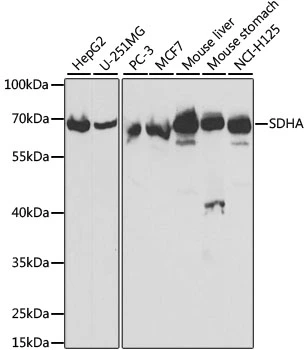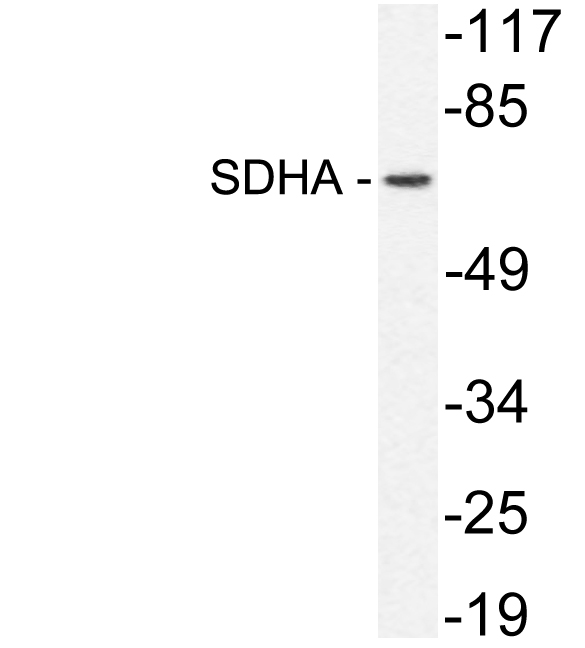SDHA antibody
GTX101689
ApplicationsImmunoFluorescence, Western Blot, ImmunoCytoChemistry, ImmunoHistoChemistry, ImmunoHistoChemistry Paraffin
Product group Antibodies
TargetSDHA
Overview
- SupplierGeneTex
- Product NameSDHA antibody
- Delivery Days Customer9
- Application Supplier NoteWB: 1:500-1:3000. ICC/IF: 1:100-1:1000. IHC-P: 1:100-1:1000. *Optimal dilutions/concentrations should be determined by the researcher.Not tested in other applications.
- ApplicationsImmunoFluorescence, Western Blot, ImmunoCytoChemistry, ImmunoHistoChemistry, ImmunoHistoChemistry Paraffin
- CertificationResearch Use Only
- ClonalityPolyclonal
- Concentration0.31 mg/ml
- ConjugateUnconjugated
- Gene ID6389
- Target nameSDHA
- Target descriptionsuccinate dehydrogenase complex flavoprotein subunit A
- Target synonymsCMD1GG, FP, MC2DN1, NDAXOA, PGL5, PPGL5, SDH1, SDH2, SDHF, succinate dehydrogenase [ubiquinone] flavoprotein subunit, mitochondrial, flavoprotein subunit of complex II, malate dehydrogenase [quinone] flavoprotein subunit, succinate dehydrogenase complex, subunit A, flavoprotein (Fp)
- HostRabbit
- IsotypeIgG
- Protein IDP31040
- Protein NameSuccinate dehydrogenase [ubiquinone] flavoprotein subunit, mitochondrial
- Scientific DescriptionThis gene encodes a major catalytic subunit of succinate-ubiquinone oxidoreductase, a complex of the mitochondrial respiratory chain. The complex is composed of four nuclear-encoded subunits and is localized in the mitochondrial inner membrane. Mutations in this gene have been associated with a form of mitochondrial respiratory chain deficiency known as Leigh Syndrome. A pseudogene has been identified on chromosome 3q29. [provided by RefSeq]
- Storage Instruction-20°C or -80°C,2°C to 8°C
- UNSPSC12352203
References
- Toda T, Ito M, Takeda JI, et al. Extremely low-frequency pulses of faint magnetic field induce mitophagy to rejuvenate mitochondria. Commun Biol. 2022,5(1):453. doi: 10.1038/s42003-022-03389-7Read this paper
- Imai Y, Inoshita T, Meng H, et al. Light-driven activation of mitochondrial proton-motive force improves motor behaviors in a Drosophila model of Parkinson's disease. Commun Biol. 2019,2:424. doi: 10.1038/s42003-019-0674-1Read this paper
- Sánchez I, Balagué E, Matilla-Dueñas A. Ataxin-1 regulates the cerebellar bioenergetics proteome through the GSK3β-mTOR pathway which is altered in Spinocerebellar ataxia type 1 (SCA1). Hum Mol Genet. 2016,25(18):4021-4040. doi: 10.1093/hmg/ddw242Read this paper




